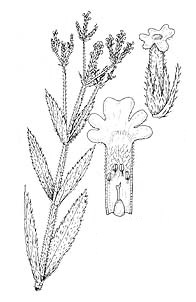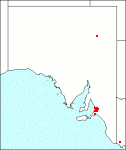Family: Verbenaceae
Verbena bonariensis
Citation:
L., Sp. Pl. 20 (1753).
Synonymy: Verbena bonariensis Common name: Purple-top, purple-top verbena.
Description:
Rigid erect scabrous-hairy perennial up to 2 m high; stem sharply and conspicuously quadrangular, somewhat scabrous-pubescent or hispidulous especially on the ridges, often 3-branched at the base; leaves sessile, oblong-lanceolate, half-clasping, 4-22 cm long, 0.6-7 cm wide, coarsely incised-serrate, rugose, scabrid and more or less villous above, tomentose beneath.
Inflorescence spicate; spikes compact terminally, cylindrical, becoming corymbose panicles 0.5-5 cm long in fruit; bracts equalling or shorter than the calyx, concave, lanceolate-acuminate, pubescent or minutely hirsute and ciliate, not glanduliferous; flowers very small; calyx 5-toothed, 2.5-3.5 mm long, pubescent, hispidulous on the angles; corolla blue, a dark violet-purple or lavender-pinkish, with the tube scarcely twice as long as the calyx, pubescent outside and in the throat; the limb small, inconspicuous, nearly regular; stamens of unequal length, included.
--V. trichotoma Moench, Suppl. Meth. 131 (1802); V. quadrangularis Vell., Conc. Fl. Flum. 16 (1825); Ic. 1:t. 39 (1836).

| Flowering branch, flower and opened flower.
|
Image source: fig. 545A in Jessop J.P. & Toelken H.R. (Ed.) 1986. Flora of South Australia (4th edn).
|
Published illustration:
Rickett (1970) Wildflowers of the United States 2, 2:pl. 170; Cunningham et al. (1982) Plants of western New South Wales, p. 569; Munir in Morley & Toelken (1983) Flowering plants in Australia, fig. 175.
|
|
Distribution:
|
S.Aust.: SL. W.Aust.; Qld; N.S.W.; Vic.. Native to temperate South America, introduced into and now widespread in other parts of North and South America, West Indies, parts of Europe and Africa, tropical Asia and the Pacific. In many areas it is an aggressive weed in cultivated and otherwise disturbed land.
|
Conservation status:
native
Flowering time: mainly Oct. — Jan.
|

SA Distribution Map based
on current data relating to
specimens held in the
State Herbarium of South Australia
|
Biology:
No text
Author:
Not yet available
|

